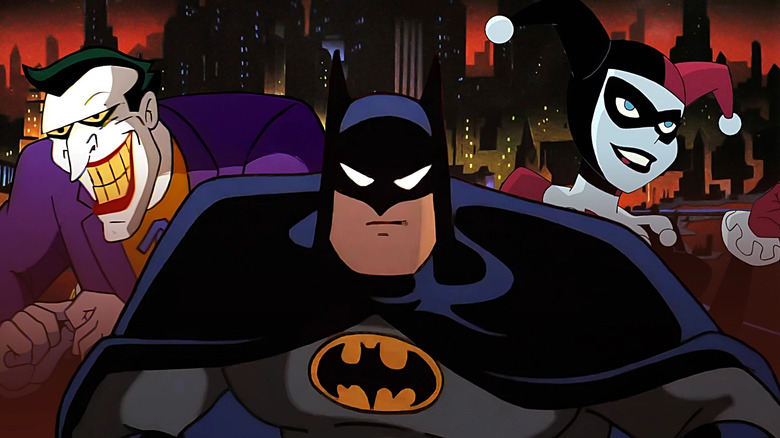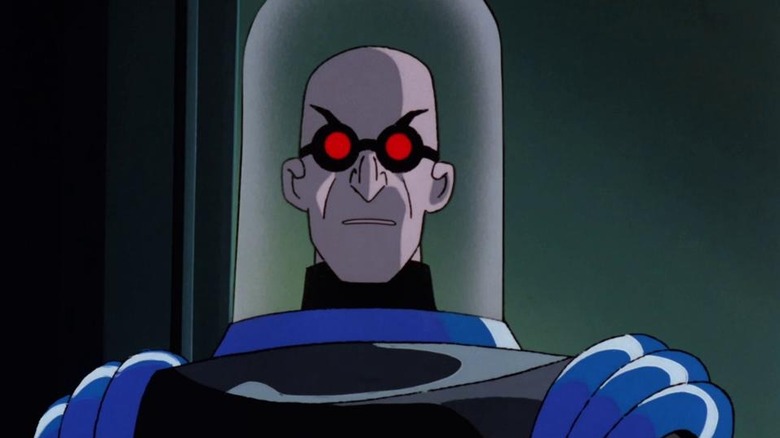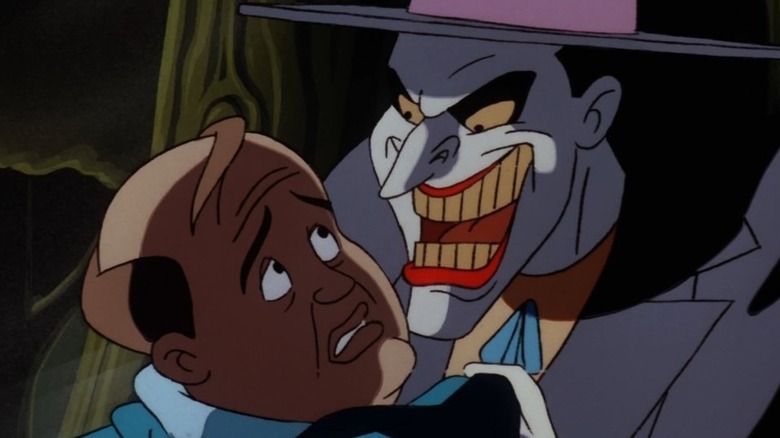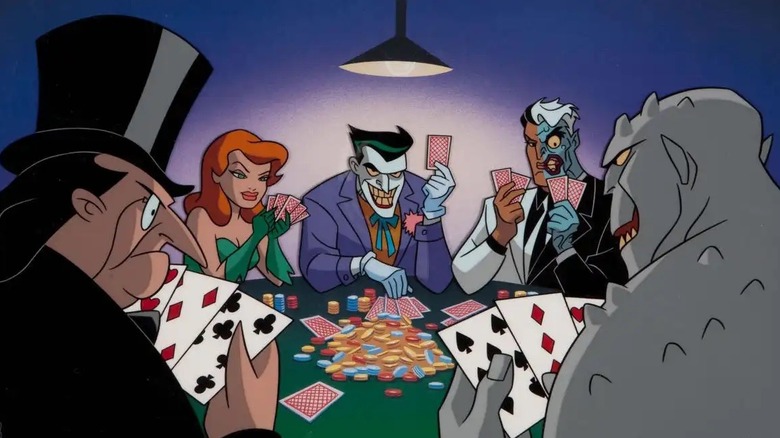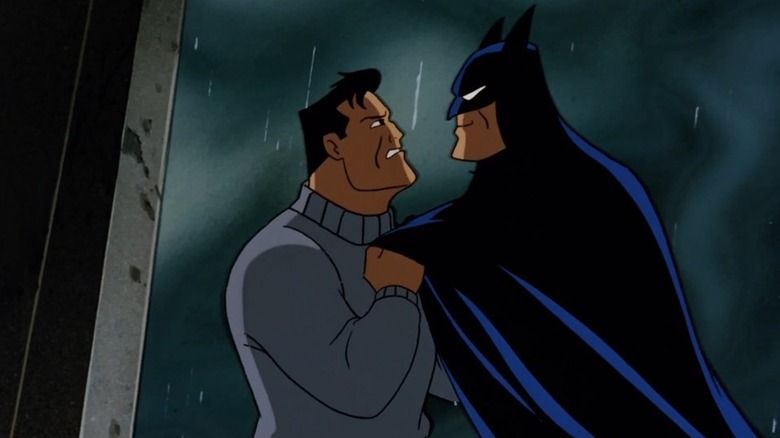5 Essential Batman: The Animated Series Episodes That Everyone Should Watch At Least Once
We may receive a commission on purchases made from links.
If you're in need of a Batman fix, you can't go wrong with "Batman: The Animated Series." Since its premiere in 1992, many have deemed this Batman show to be the definitive take on the Dark Knight. A lot of what we consider to be the archetypal Batman comes from the series. Gothic atmosphere dripped from its animation frames and the orchestral score sounded right out of the Tim Burton "Batman" films. (It almost literally was, since series composer Shirley Walker had previously conducted for Burton's composer, Danny Elfman.) On the topic of sound: The late Kevin Conroy, who provided the voice performance for Batman/Bruce Wayne, was the ideal actor for the character.
The relatively mature storytelling of "Batman: The Animated Series" also redefined expectations about what an American children's cartoon could be. Yet its ambitious writing was also economical; stories fit into tight 22-minute runtimes. At its best, "Batman" felt less like mere cartoon episodes and more like short films, just like the Fleischer Studios "Superman" cartoons of the 1940s.
The legacy of "Batman: The Animated Series" lives on in how it has inspired other programs. Many of the edgier cartoons of the 1990s and 2000s (say, "Gargoyles") were flying on the path that Batman had first charted. "The Animated Series" itself came back for 24 more episodes in 1997, with new animation and a new title, "The New Batman Adventures." Conroy's Batman later joined "Justice League," the culmination of a full-blown DC Animated Universe.
The new cartoon "Batman: Caped Crusader" isn't an official sequel to "The Animated Series," but it was also developed by Bruce Timm and shares style and moods with the '90s show. "Caped Crusader" is more serialized, though, whereas "Batman: The Animated Series" was designed so each episode could stand alone. Of its 85 episodes, which are the most essential to see if you're a series newcomer? Here are the five you absolutely have to watch.
Heart of Ice
Long before Heath Ledger and then Joaquin Phoenix's Oscar wins for playing the Joker, "Heart of Ice" is the episode that proved Batman could be an awards contender. Directed by Bruce Timm and written by Paul Dini, this episode won a Daytime Emmy Award for Outstanding Writing in an Animated Program.
This is the episode that changed Mr. Freeze, previously one of the lamer Batman villains, into a tragic A-lister. The "Animated" Freeze (Michael Ansara) boasted a sleek redesign from comic artist Mike Mignola and a tragic backstory.
Once, Freeze was an ordinary cryogenicist, Victor Fries, employed at Gotham City company GothCorp. Then his beloved wife Nora came down with a terminal illness. Fries used GothCorp's tech to build a cryogenic chamber for Nora, hoping she could rest in suspended animation until he could find a treatment to save her. GothCorp CEO Ferris Boyle (Mark Hamill) violently pulled the plug, (presumably) killing Nora and leaking chemicals that mutated Victor. Now, Fries/Freeze must stay in sub-zero temperatures to survive, hence his suit and freezing ray.
Victor not only lost his love, his transformation means he can never find another, nor enjoy simple pleasures like the warmth of the sun or another's touch. Freeze is frozen in time, driven only by murderous revenge towards Boyle. As Freeze himself says of his backstory: "It would move me to tears if I still had tears to shed." Freeze's heart may be as cold as ice, but odds are good that "Heart of Ice" will melt yours (and not in a happy way).
Joker's Favor
You can't have Batman without the Joker. The "Animated Series" Joker (Hamill, who leveraged his guest spot as Boyle into a full-time job) is the equal and opposite to Conroy's Batman. He was naturally the series' most recurring villain, getting substantial roles in more than a dozen episodes and the movie "Batman: Mask of the Phantasm."
There's a lot of good Joker episodes to choose from, but my favorite is always going to be "Joker's Favor" (written by Dini, directed by Boyd Kirkland). It's the scariest Hamill's Joker ever gets in the show because he doesn't spend most of it pranking Batman. Instead, he's after everyman Charlie Collins (Ed Begley Jr.). After an ordinary but lousy day, a frustrated Charlie cusses out a driver who cuts him off on the highway. His day then gets a whole lot worse, because the Joker was the one who cut him off.
The first act of "Joker's Favor" is truly unsettling. Charlie doggedly tries to escape the Joker, but every way he turns, the Joker is there first. While the Joker is no joke, Batman can handle him. Charlie can't. So when the Joker finally corners him, he pleads for his life, saying he'll do anything. The Joker's ears perk up at that, so he decides to let Charlie go, but Mr. Collins will one day have to do a favor for the Joker, of the Joker's own choosing. Charlie is left with no idea of what he'll have to do, or when, and then the episode jumps to when the Joker finally cashes in his favor.
"Joker's Favor" is an incidentally historic episode for another reason: It's the first ever appearance of Harley Quinn (Arleen Sorkin)! Though just a mere moll in this episode, her storied legacy began right here.
Beware the Gray Ghost
"Beware the Gray Ghost" is the most metatextual episode of "Batman: The Animated Series," and it's beloved because of that. The special guest star of the episode is Simon Trent (Adam West), a washed-up actor who once played masked hero the Gray Ghost in old film serials. Who was the Gray Ghost's biggest fan? A young Bruce Wayne, who modeled Batman on the Gray Ghost (the Gray Ghost fills the role Zorro usually does as Batman's childhood hero.)
When some bombings erupt around Gotham, Batman recognizes them from an old Gray Ghost film. He tracks down Trent, who is at first bitter about his old role and how it typecast him, but ultimately digs up the Gray Ghost costume to help out Batman.
This episode (story by Dennis O'Flaherty and Tom Ruegger, scripted by Garin Wolf, and directed by Boyd Kirkland) reveals the childish side of Batman, but not in a mean-spirited way. Many writers and fans say that Bruce Wayne lost his childhood when his parents were murdered. But it's just as valid to argue that Bruce never grew up at all. We see in "Beware the Gray Ghost" that being Batman is literally him living out a childhood memory, and holding onto happy memories of his dad (who watched the Gray Ghost films with him).
It should be clear why West, who played Batman in the 1960s "Batman" series, is playing the part of Trent. He was the childhood Batman of this show's creators, affecting them the way that the Gray Ghost did young Bruce. (Bruce grew up to be Batman, while Timm and co. grew up to write and draw Batman.)
Trent's resentment of his most famous role rings true to West's own life. Adam West passed in 2017, and to this day we still remember him mostly as Batman. But "Beware the Gray Ghost" argues that's a legacy to be proud of, and hopefully Mr. West realized that.
Almost Got 'Im
One of Dini's "Batman" writing flourishes was to put Batman himself in a supporting role. Gotham City is so filled with colorful characters that not every episode needed the hook of Batman taking down one of the costumed heels. The best example of this is "Almost Got 'Im" (written by Dini, directed by series co-creator Eric Radomski).
In a bar on the bad side of Gotham, Joker, the Penguin (Paul Williams), Two-Face (Richard Moll), Poison Ivy (Diane Pershing), and Killer Croc (Aron Kincaid) all sit around a table playing poker. As they gamble, their talk turns to the common bat-shaped factor in their lives. The villains speculate on who the Dark Knight really is and swap stories about the times each of them came the closest to killing Batman.
"Almost Got 'Im" is the perfect Batman sample platter. The show is banking on you being familiar with these bad guys by now, but it's still friendly to newcomers. The anthology structure allows "Almost Got 'Im" to show off five villains at once. Each segment explains their gimmick based on the death trap they use to try and snuff Batman.
-
Ivy: exploding pumpkins filled with toxic gas.
-
Two-Face: tying Batman to a giant coin and flipping it.
-
Penguin: trapping Batman in a zoo pen with a cassowary.
-
Joker: hijacking a late night talk show to broadcast Batman being zapped in an electric chair, live.
-
Killer Croc: throwing a rock — a big rock — at Batman.
But experienced fans get a treat, too. The framing device lets all the villains interact with each other, when usually only one would show up per episode. The card table scenes also come with proper noir-ish lighting and an old-timey jazz score, because "Batman" never skimped on atmosphere. While Batman himself has little dialogue, the episode is a testament to his resourcefulness; again and again, he escapes certain death. The bad guys all talk up what a pain Batman is, but actions truly speak louder than his words.
Perchance to Dream
Kevin Conroy went on record that his favorite "Batman: The Animated Series" episode was "Perchance to Dream." It's an understandable pick because, unlike some others, Batman himself is absolutely the star of "Perchance to Dream" (plotted by Laren Bright and Michael Reaves, scripted by Joe R. Lansdale, and directed by Kirkland). That lets Conroy act his heart out because the episode puts Batman through the emotional ringer.
In "Perchance to Dream," Bruce awakens and finds everything is as upside down as a sleeping bat. His parents are still alive and well, he's engaged to Selina Kyle (Adrienne Barbeau), and though Batman exists, he's not Bruce. Mr. Wayne can rest easy that someone is still protecting Gotham. It just doesn't have to be his responsibility (or martyrdom) anymore. But despite the temptation, Bruce slowly realizes (as you probably did from the episode title) that this new world is too good to be true.
Speaking of the title, its taken from a turn of phrase in the "to be, or not to be" soliloquy from "Hamlet," where it refers to the allure of suicide and dreaming forever. It's a fitting choice, and not just because this is an episode about dreams (both literal ones and wistful wishes). Batman spends the episode contemplating himself like Hamlet was: Should he accept a permanent dream where all his deepest desires are fulfilled, or a darker reality?
"Batman: The Animated Series" is available to stream on HBO Max and for purchase as a Blu-ray set.
